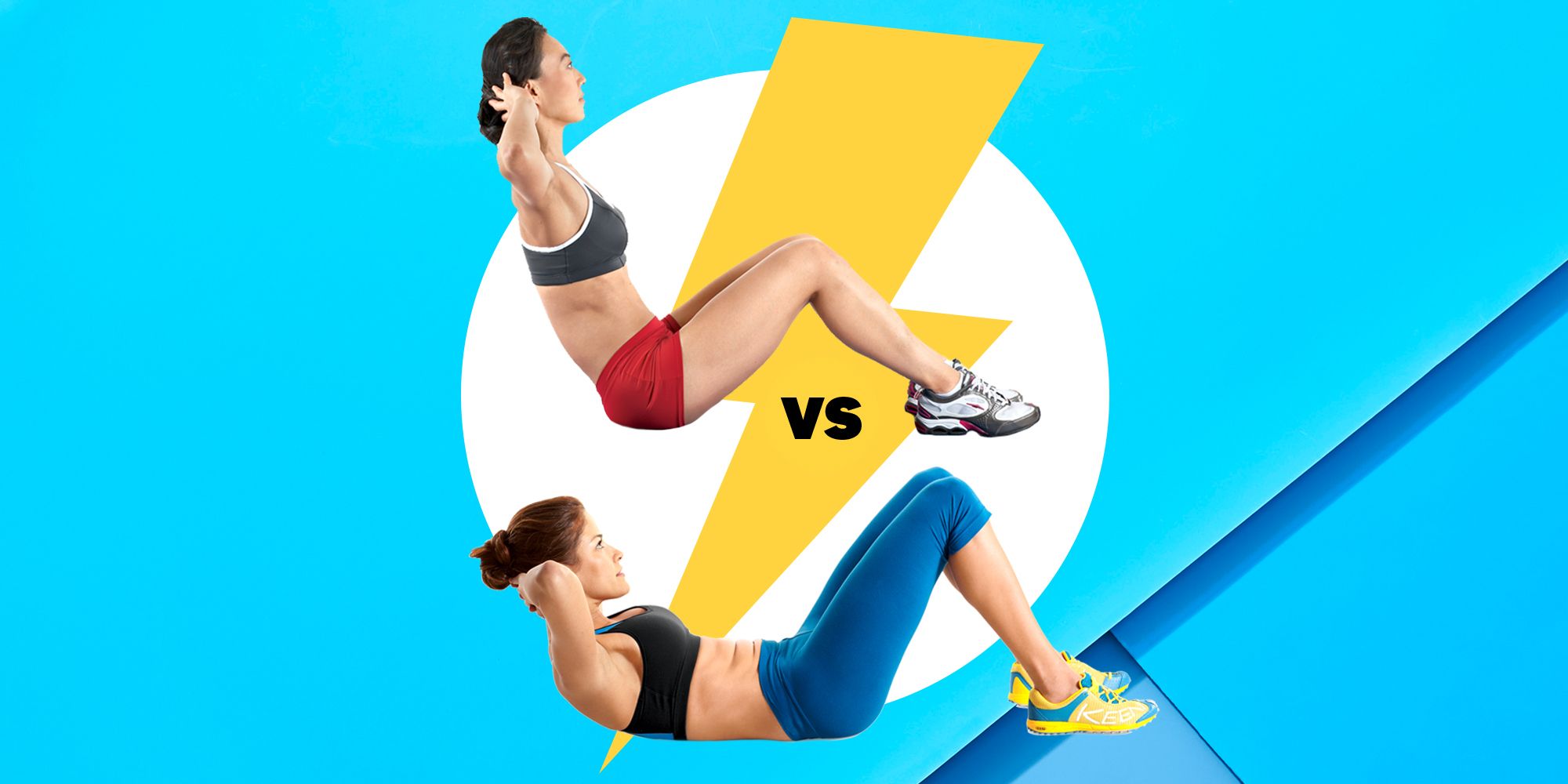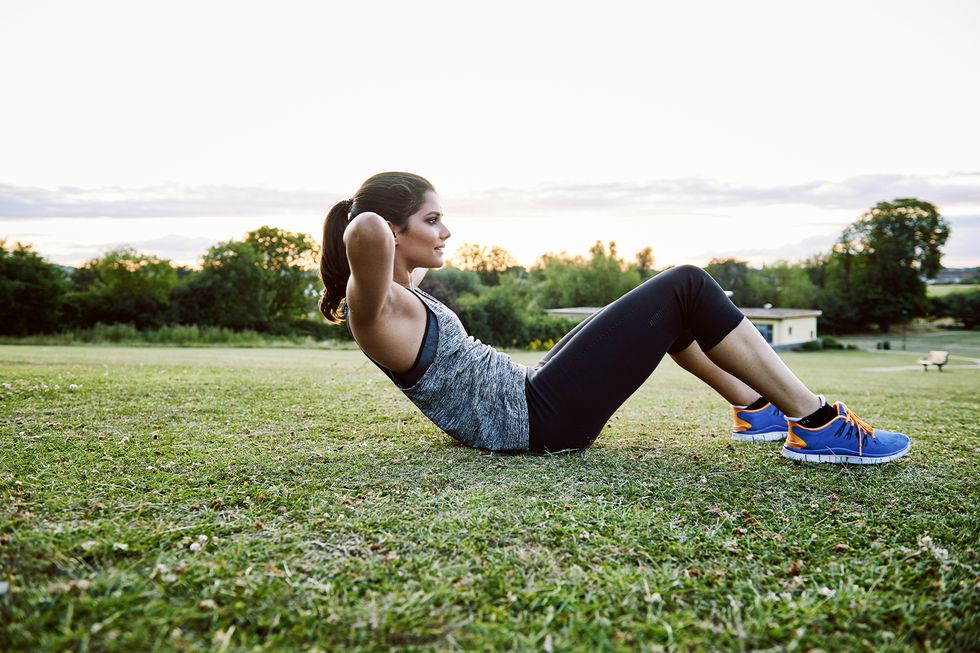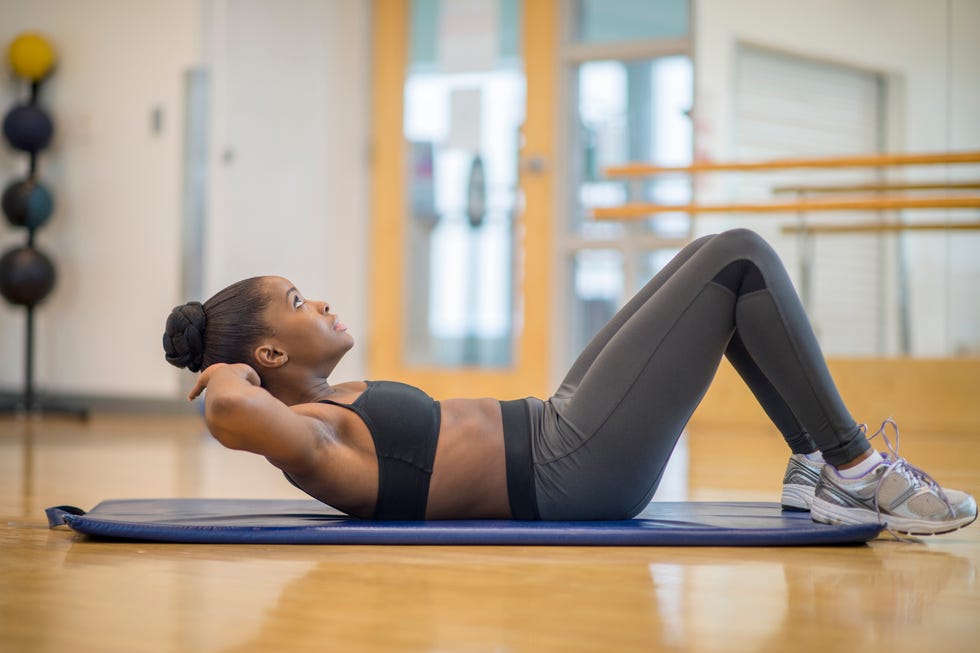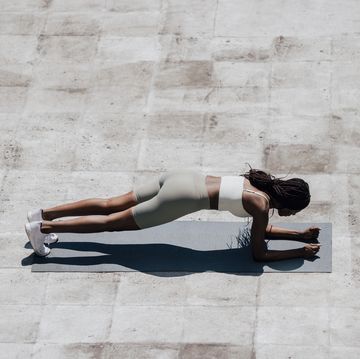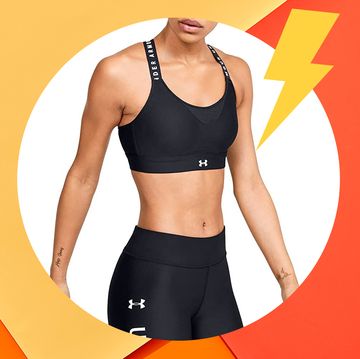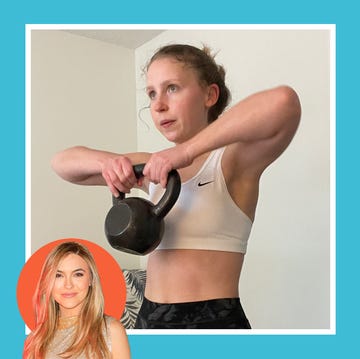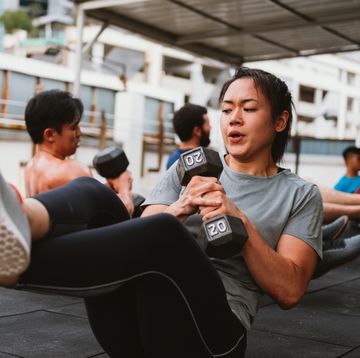Despite what you may think, crunches and sit-ups are not synonymous. Shocker, I know. You've probably done more reps of these popular abs exercises than you can count. You know they're both meant to strengthen your core, but the details are somewhat fuzzy from there.
So, what is the difference between sit-ups and crunches anyway? “The main difference between the two is that unlike a sit-up, in a crunch, the lower back never leaves the floor,” explains Katharine Glazer, CPT. Basically, a crunch is a more targeted and isolated exercise that only works your rectus abdominis (primarily your upper six-pack).
Meet the experts: Olivia Amato is a certified personal trainer and bike, tread, boot camp, and strength instructor for Peloton. Katharine Glazer is a certified personal trainer. Amanda Edell is a NASM- and ACSM-certified personal trainer and holistic health coach with 12 years of fitness experience.
More From Women's Health

A sit-up, on the other hand, has a larger range of motion and targets multiple muscle groups at the same time—rectus abdominis, hip flexors, transverse abdominis (deep core muscles), obliques (side abs), and lower back muscles. By raising your torso fully off the ground, you're recruiting more muscles.
Let's cut to chase, is one exercise “better” for you? Well, that depends on the muscle you want to target, Glazer says. “Every body has unique demands and requirements, there is no one size fits all."
- If you're looking to get the most bang for your buck and work multiple muscle groups at once, then sit-ups have an edge.
- Aiming for intense muscle isolation instead? Crunches could be your jam.
- But, trainers actually prefer other more effective abs moves over sit-ups and crunches.
That said, there's a lot more to know about the great crunches vs. sit-ups debate. Keep reading for the benefits and risks of both sit-ups and crunches, plus how to nail your form and which one deserves a slot in your routine, according to experts.
Benefits Of Sit-Ups
- Work *multiple* muscle groups. So yeah, sit-ups help you sculpt your abs (and more!) from lots of angles at once when done with proper form, says Olivia Amato, CPT, a Peloton instructor.
- Improve stabilization. If you’re looking to work on your stabilization, sit-ups are def for you. Why? Lifting your whole torso from the ground engages your balance-focused muscles like your abs, hip flexors, legs, back, and neck, Glazer explains.
- Better posture. Sitting and standing a bit straighter is a bonus of engaging all those stabilizing muscles, Amato adds.
- Increase flexibility. Sit-ups, when done properly, loosen up both your spine and your hips. That motion helps to increase flexibility, explains holistic health coach Amanda Edell, CPT. Better flexibility snowballs into other perks, like leveled-up performance and fewer injuries.
How To Do A Proper Sit-Up
- Lie on your back with knees bent at 90 degrees and feet flat on the floor. Place your fingertips on the back of your ears, with elbows bent and pointing out to the side.
- Take a deep inhale, then exhale as you contract your core muscles and lift your torso off the ground. Continue until your chest is as close to your thighs as possible. (Though if you don't make it all the way there, no worries!)
- With a smooth and steady motion, inhale as you lower back down to the starting position. That's one rep. Start with 10 reps and add as you feel more confident!
Form tip: “I love doing sit-ups when I have a table to anchor my feet on or a workout buddy holding my feet down with their hands,” says Amato. “This usually ensures proper form because you don't have to worry about keeping your feet on the ground on top of everything else.”
Sit-Up Variations To Try
Sit-Up With A Twist
- Lie on your back with knees bent at 90 degrees and feet flat on the floor. Place your fingertips on the back of your ears, with elbows bent and pointing out to the side.
- Take a deep breath in, contract your core muscles, and lift your torso off the ground as you exhale.
- At the top, rotate your torso to touch your right elbow to your left knee.
- Twist back to center and inhale as you lower back to starting position.
- Repeat on the opposite side. That's one rep.
Weighted Sit-Up
- Lie on your back with knees bent at 90 degrees and feet flat on the floor, holding a weight (medicine ball, dumbbell, or weight plate) with both hands at the center of your chest.
- Take a deep breath in, contract your core muscles, and lift your torso off the ground as you exhale.
- Inhale as you lower back to the starting position. That's one rep.
Stability Ball Sit-Up
- Sit on a stability ball (Swiss ball) with feet flat on the floor.
- Slowly lean back, bending at hips and walking feet out, until your torso is at a 45-degree angle with quads and thighs are parallel with the floor.
- Place your fingertips on the back of your ears, with elbows bent and pointing out to the side.
- Take a deep breath in, contract your core muscles, and lift your torso off the ball as you exhale.
- Inhale as you lower to return to the starting position.
Benefits Of Crunches
- Defined upper abs. Crunches isolate the upper abdominals and are great when aiming for high rep counts, says Amato. “I find that crunches are a move I can do continuously because they're a simple, low-impact exercise,” she explains.
- Easy to master form. “With crunches, you just need to focus on lifting your head and shoulders off of the floor while supporting your neck, so it's easier to get the move down and perform without feeling muscle pain," says Amato.
- Low risk of injury. Crunches involve a small range of motion, so the risk of injury is also small. Lift higher up off the ground and your hip flexors might begin to activate, putting stress on the spine, Edell says. The minimal movement required for crunches allows you to strengthen your core without putting undue strain on your back.
How To Do Crunches With Proper Form
- Lie on your back with knees bent at a 90 degree angle, keeping your feet flat on the floor.
- Place your fingertips on the back of your ears, elbows bent and pointing out to the side.
- Take a deep breath in, contract your core muscles, and then lift only your head and shoulder blades from the ground, exhaling as you rise. (Keep your chin tucked, but not touching your chest, and let your head be heavy in your palms to put more work into your abs.)
- Inhale as you lower to starting position. That's one rep. Start with 10 reps and, if you feel like you've got the hang of things, keep goin' for 20 to 30.
Pro tip: “Crunches can sometimes feel repetitive, but I find that when they do, I just add a twist—pointing one elbow toward opposite knee—to spice things up or crunch to the beat of a song,” Amato says.
Crunch Variations To Add To Your Routine
Bicycle Crunch
- Lie on your back with knees at a 90-degree angle and feet flat on the floor.
- Place your fingertips on the back of your head with elbows bent and pointing out to the side.
- Exhale and bring right elbow to left knee while extending right leg straight, rotating torso, and bringing left elbow to touch the ground.
- Inhale as your return to start and repeat on opposite side. That's one rep.
Reverse Crunch
- Start lying on back with hands by sides and feet lifted off the ground at a 45-degree angle, toes pointed. Press your lower back into the ground and keep your arms at your sides.
- Brace your core, push down into arms, and exhale as you curl your knees toward your chest until hips lift off mat.
- Inhale and slowly return to the starting position. That's one rep.
So, are crunches or sit-ups a better workout?
Both can help you build abdominal strength, and each exercise comes with its own set of pros and cons. Assess which might be best for your skill level and safety, then get to work.
Keep in mind, there’s a greater risk of injury with sit-ups. While doing sit-ups helps build muscle, there is an increased risk of injury when incorporating them into your exercise routine. “The problem with sit-ups is that it’s very difficult to do the exercise correctly without rounding the lower back, which increases stress on the lumbar spine,” explains Glazer.
For this reason, “trainers tend to have their clients avoid sit-ups to decrease the risk of injury,” she says. That's also why Edell prefers crunches. “There is less flexion and extension of the spine, which means less chance for injuries,” she says.
Crunches are super beneficial when it comes to sculpting the top of your six-pack, but that's actually *also* their downfall. Crunches *only* target your upper abdominals. “The problem with crunches is that since the hips and legs are stationary, you’re not fully activating the lower abdominals, nor are you engaging the obliques,” Glazer explains.
Bottom line: Crunches have a slight edge on sit-ups, but both have limitations. “If you’re looking to strengthen your entire core, there are a plethora of other abs exercises that’ll give you a greater return,” says Glazer.
Madeline Howard is a writer, editor, and creative based in Brooklyn. Her work has been published in Esquire, Nylon, Cosmopolitan, and other publications. Among other things, she was formerly an editor at Women’s Health. Subscribe to her newsletter ‘hey howie’ at madelinehoward.substack.com.
